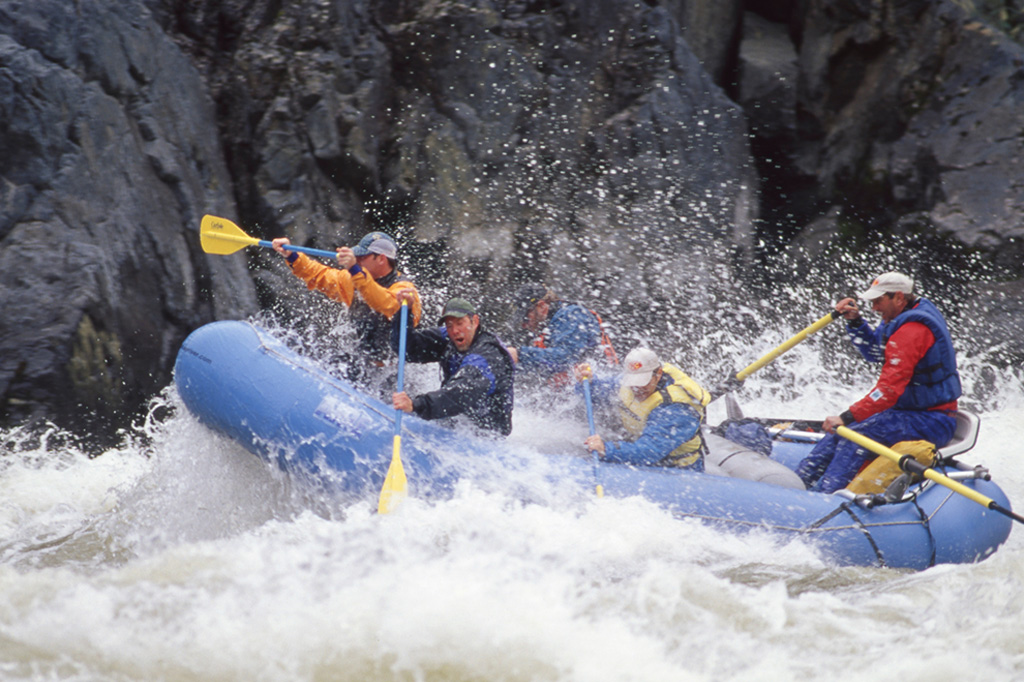For any would-be bucket lister, Idaho is a cornucopia of adventure worthy of any lifetime achiever’s aspirations. With 35 million acres of public land, 100,000 miles of rivers, and dozens of mountain ranges in the heart of the Rocky Mountains, it’s easy to build a lifetime to-do list of outdoor adventures. Less obvious but equally deserving are more domestic and cultural activities that could range from visiting a local winery to unearthing and cooking an Idaho-grown potato. The limits are bounded only by your imagination and personal tastes.
While compiling a lifetime achievement list for Idaho is fairly straightforward, it’s impossible to tailor a bucket list suitable for people of every ability or interest. With that in mind, we built the following list using a few basic parameters. The activities are geographically and substantively diverse, and while they’re not reserved for experts alone, most aren’t for novices, either.
What this means for any
aspiring Idaho bucket lister is that you have to participate in building your own list. Use the following pages of top-tier Idaho activities as a starting point, then build your own list and get out there. The stunning beauty and warm-hearted people of Idaho await.
Paddle One of the Big Four
Idaho has more than 100,000 miles of rivers and streams, with more than 3,100 miles of whitewater suitable for rafting, kayaking and canoeing. Idaho also has some of the best and most prized Wild and Scenic Rivers in the nation. These are free-flowing rivers revered nationally for their outstanding water quality, wilderness character and stunning scenery.
Four of those—the legendary Middle Fork of the Salmon, Selway, Main Salmon and Snake River through Hells Canyon—are so good and highly sought after that permits are issued using a randomized lottery system administered by the U.S. Forest Service.
“These are Idaho’s big four: They’re all Wild and Scenic, and they’re all national treasures,” said Kevin Lewis, conservation director at Idaho Rivers United, a nonprofit advocate for Idaho’s rivers. “Idaho is unique in that we have so many miles of really special wilderness rivers. No other state in the lower 48 really compares.”
While they collectively constitute a national treasure, each of the four rivers is unique.
The Snake River in Hells Canyon is a large-volume river at the bottom of North America’s deepest canyon and flows through a predominantly desert ecosystem.
The Middle Fork of the Salmon is a mountain river that starts in heavily forested mountains at around 7,000 feet. “It’s just world famous as one of those runs that everybody has to do,” Lewis said.
The Main Salmon is a larger river below the Middle Fork confluence. It flows through a mix of forest and desert ecosystems and has big sand beaches and lazy long pools between rapids.
The Selway flows through Northern Idaho’s lush coniferous forests and is the most difficult for which to obtain a permit. There’s only one launch per day, which ensures lots of elbow room but makes it that much more difficult to actually get on the river. “We rafted it last week and didn’t see another party our whole trip,” Lewis said in mid-July. “It is isolated with crystal clear water and a short season.”
Idaho’s official moniker is The Gem State, but it could just as easily be The River State, The Paddling State or, as one of the state’s guidebooks coined it, The Whitewater State. It is unmatched in its quality and quantity of big, beautiful rivers and scenic mountain lakes that are waiting for paddlers of all abilities to dip a paddle, take a stroke and start exploring, and the big four are worthy of your bucket list.
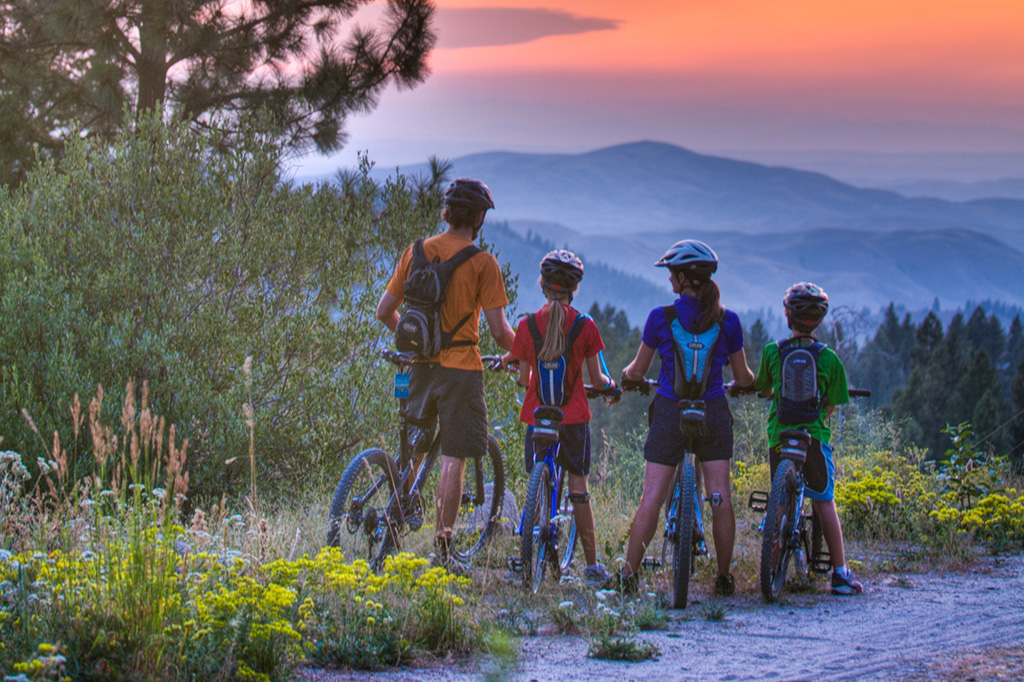
The summit of Shafer Butte at Bogus Basin Ski Resort. Photo: Chad Case / Idaho Stock Images
Bike the Boise Front
From custom-built bike parks at Sun Valley, Grand Targhee, Brundage, Schweitzer and other resorts, to rolling desert single track around Twin Falls, Idaho has an incredible array of mountain biking to choose from and dozens of rides worthy of any Gem State bucket list. Among all the thousands of miles of winding dirt, however, there’s not much that compares with the huge, high-speed descent from Bogus Basin to Boise, which, route depending, adds up to more than 5,000 vertical feet of mostly downhill riding.
There’s no single trail that descends from the top to the bottom, so some creativity is required to link them together. In general, though, there are two fundamental ways to get from the 7,500-foot summit of Shafer Butte back to the city at 2,700 feet.
“It’s like a choose-your-own adventure with all the trail choices you have,” said Layton Martin, who’s been mountain biking in Boise more than 15 years and manages the service desk at Joyride Cycles. “I’d say it’s very comparable to The Whole Enchilada (a famous downhill trail near Moab, Utah). You start up high in the trees and drop thousands of feet into the desert.”
For the maximum amount of single track that doesn’t intersect dirt roads, link the Bogus Basin trails with East Side, Sweet Sweet Connie, Peggy’s, and Polecat. For this combination you drive to Pioneer Lodge at 6,800 feet and climb to the summit of Shafer Butte or immediately start your descent via Morningstar or Berm Baby Berm. Once at Simplot Lodge at the main base, cross the road and locate East Side Trail, which weaves among shady pines while dropping 1,000 feet and climbing about 500. The top of Sweet Sweet Connie zigzags in steep switchbacks but mellows as it begins to parallel Daniels Creek. From there it’s a long, sweeping descent that connects to Peggy’s Trail and Cartwright Road, where you cross and ride the Polecat Loop back to town.
The other fundamental route requires more time on a fire road but includes very high-quality single track. It starts at Bogus Basin and exits the resort at the top of Deer Point onto Ridge Road. A shady, wooded and somewhat technical trail called Mahalo is recommended but not required before turning onto one of three long downhills on Dry Creek, Shingle Creek, or Hard Guy trails. Both Dry Creek and Shingle Creek are somewhat technical, while Hard Guy is pretty straightforward.
It’s worth noting that there’s no way to enjoy the huge descent from Bogus Basin to Boise without at least 1,000 feet of climbing. These rides require commitment, and riders should be prepared for emergencies and a minimum of two to three hours on the trail.
“It’s amazing to hit all the different climate and vegetation zones all in one ride and then be able to come back to Hyde Park at the end of it and get a beer,” Martin said. “It’s pretty unique.”
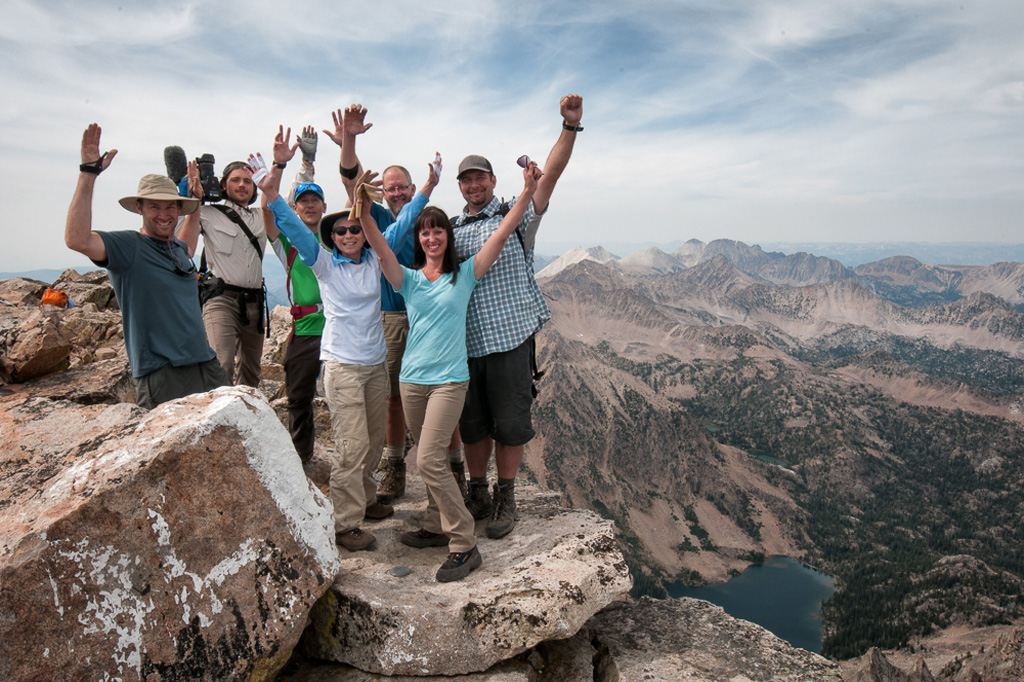
On the summit of Castle Peak in the Cecil D. Andrus-White Clouds Wilderness. Photo courtesy Idaho Public Television / Tim Tower.
Climb a Storied Summit
A seasoned peak bagger could spend a lifetime climbing Idaho’s numerous stony spires. The Sawtooth Mountains alone have 57 peaks over 10,000 feet, and any one of them is worth adding to a bucket list. The state’s highest peak, 12,667-foot Mount Borah, is another worthy goal, but for this list we’re selecting a mountain with debatably better views and a lot more significance to the state’s history and identity.
At 11,815 feet above sea level, Castle Peak towers over Idaho’s newest wilderness area, the 91,000-acre Cecil D. Andrus—White Clouds Wilderness. It’s a celebrated landscape that hosted land-use skirmishes for more than 40 years until its wilderness designation in August 2015. The fighting began in the 1970s when the people of Idaho staved off a massive molybdenum mine planned for the peak’s lower flanks. The fight drew Castle Peak and the White Clouds into the political limelight for the first time and helped effect congressional designation of the 756,000-acre Sawtooth National Recreation Area, as well as help get Gov. Andrus elected to his first of four terms.
“It’s a special place in Idaho. It’s the farthest inland that salmon swim. It’s in the coldest waters in this region. Some of the geology is fascinating,” said Betsy Mizell, the central Idaho director of the Idaho Conservation League. “But what really makes it special is that people worked on it for 40-plus years to get it designated as wilderness.”
Castle Peak can be done as a huge day trip, but it’s best over two or three days, which affords time to slow down and appreciate the Idaho backcountry. The common approach is a 10-mile hike from Fourth of July Lake Trailhead to Washington Lake, then over the ridge at the southern end of Washington Lake into Chamberlain Basin where you can set up a base camp at Lake 9197. The most frequently-climbed route is the south face’s big gully, which climbs at a right-to-left angle. The gully narrows near the top, but by following cairns you’ll successfully arrive at the summit ridge and make a relatively easy hike back to the east to achieve the summit.
Atop the summit, you’ll enjoy views east to the Lemhi Range, north to the Salmon River Mountains, west to the Sawtooths, and south to the Boulders. Castle Peak literally towers over all surrounding mountains and affords an incredible view that easily ranks as one of the best summits in Idaho.
It should go without saying that this is a fairly serious backcountry adventure and should be undertaken by physically fit groups who are prepared to deal with shifting weather and unexpected circumstances. If you don’t know, as the saying goes, don’t go.
Mizell also cautioned about the fragile backcountry. “These are high alpine areas,” she said. “They’re very fragile and only see summer for a short period of time. Please be respectful and pack out what you pack in.”
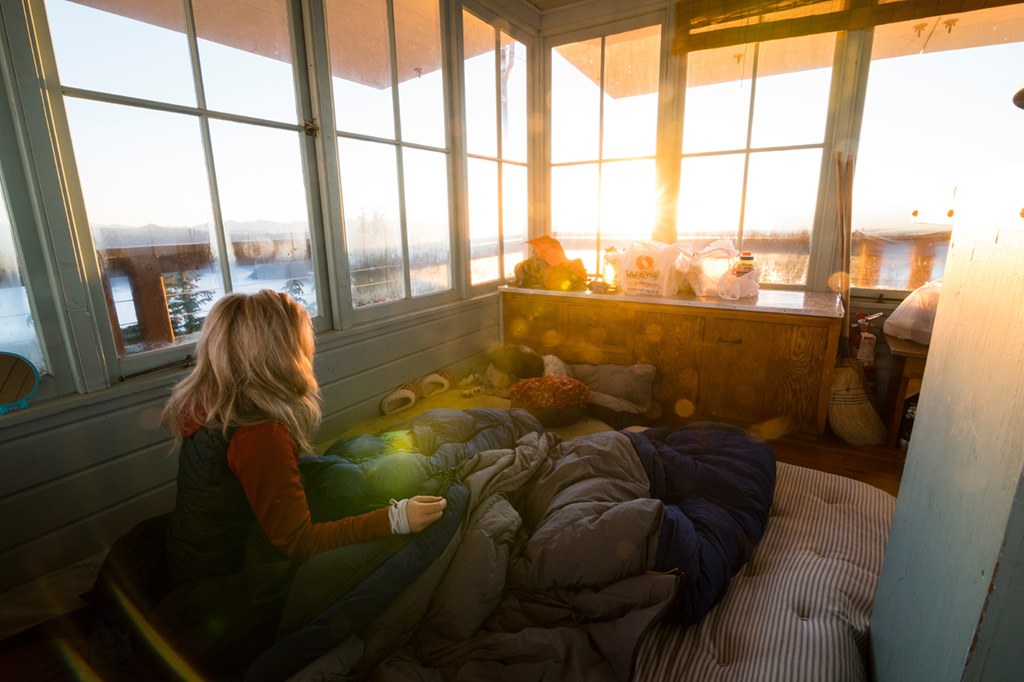
Inside the Little Guard Lookout, Panhandle National Forest. Photo: Chris Celentano / Idaho Stock Images.
Camp in a Fire Lookout
Idaho’s fire lookouts were built to sight forest fires before they grew out of control, but many have been retired, and some are available as mountaintop cabins with unparalleled views. The experience of camping in an Idaho fire lookout is easily a top bucket list contender.
“The sunsets and sunrises were absolutely spectacular,” said Idaho outdoor writer Steve Stuebner, who stayed at Arid Peak Lookout in north Idaho in August 2017. “You just lie there in your sleeping bag and watch the glow of sunrise. That was something really special, out of this world.”
A fire lookout is essentially a small box of wood with glass windows that reveal views over 360 degrees of mountains. When in service, they were staffed by a man or woman who lived there for the summer and kept a watchful eye on the surrounding forest. Most were built in the early part of the 20th century, and many were retired in the past 20 to 30 years as additional fire locating technologies came into use. Most lookouts sit on stilts, so that the view easily looks past nearby trees. Some are simply far above tree line.
According to the Forest Fire Lookout Association, an organization that helps refurbish and maintain old lookouts, there are 10 Idaho lookouts available to rent through recreation.gov. You can drive to some, like Deadwood Lookout near Deadwood Reservoir in the Salmon River Mountains. Others require a bit of hiking. Arid Peak Lookout in north Idaho near the town of Avery requires about a two-mile hike each way. Shorts Peak near Bonners Ferry requires a 2.5-mile hike.
“I just love hanging out in the afternoon, sipping a beer on a mountaintop, and enjoying the scenery,” Stuebner said. “I just think it’s a unique opportunity and would love to see more of those things being open to the public.”
With 900 such mountaintop facilities, Idaho once had more fire lookouts than any state in the nation. To peruse the offerings and book your stay, check recreation.gov and look for one of the following 10 Idaho lookouts: Arid Peak, Bald Mountain, Castle Butte, Deadwood, Deer Ridge, Little Guard, Lookout Butte, Lunch Peak, Shorty Peak, or Surveyors.
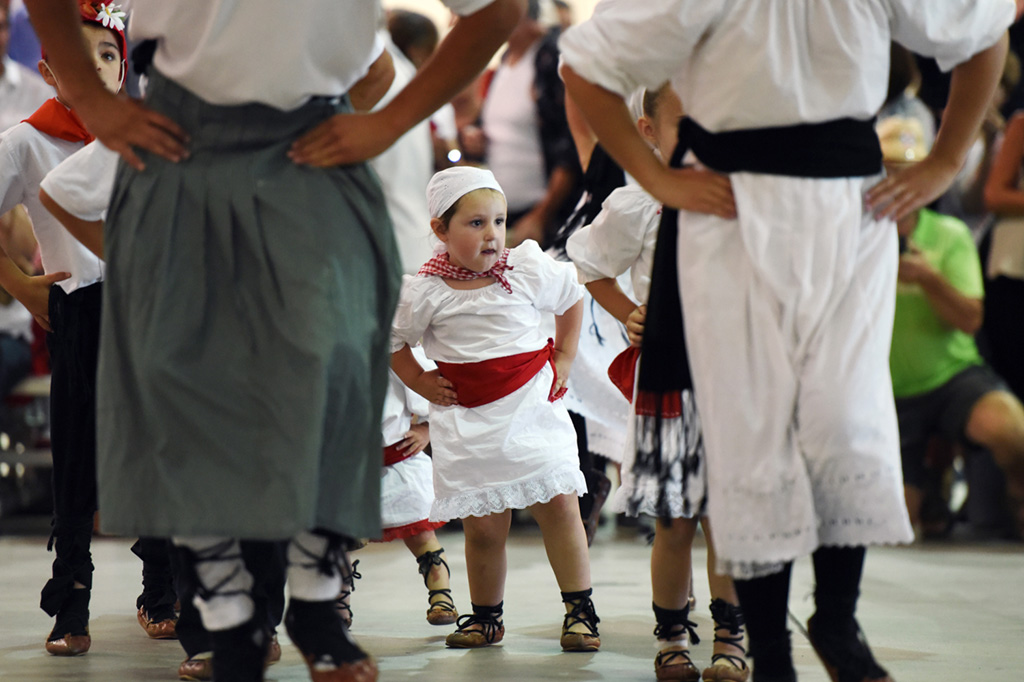
Traditional dancing is part of the Jaialdi celebration. Photo: AP Photo / Idaho Statesman, Darin Oswald.
Take a Cultural Field Trip
A cultural field trip in Idaho is as easy as looking at any community’s calendar of events. Every August there’s the Sun Valley Music Festival when classical musicians descend on central Idaho to perform classical music—for free. Every July, the McCall Music Society hosts a similar event called SummerFest. The city of Donnelly hosts an annual Huckleberry Festival. Yellow Pine has a harmonica festival. Ketchum hosts weekend-long festivals centering on the region’s mining and sheep ranching history. Challis hosts a revered music festival called the Braun Brothers Reunion. Salmon has a whitewater festival. The list is far longer than the number of cities in the state.
If you want to experience a tried and true piece of Idaho culture that’s got international significance, head to Boise for the once-every-five-years Jaialdi. The next is coming right up in late July 2020.
Jaialdi is an event that celebrates Basque culture and history in Idaho. Basques immigrated to Idaho and the Intermountain West in large numbers in the late 19th and early 20th centuries to work for the region’s booming sheep ranching and mining industries. Idaho and Nevada are now home to more Basques than any part of the world outside the Basque homeland in Spain and France.
In the native Basque language, Jaialdi literally means “Festival.” The Boise Jaialdi puts Basque culture on display with dancing, music, sport, and authentic food and drinks and draws an international crowd of 40,000 or more. Jaialdi was first celebrated in 1987 as a one-time weekend event to educate Idahoans about local Basque culture. Its wild success prompted Gov. Cecil Andrus to hold the event again in 1990 in conjunction with the state’s centennial celebration. The event is now held every five years on the last weekend of July.
John Bieter, a Basque studies professor at Boise State University, told The New York Times in 2015 that the festival is a time for Basques to celebrate and promote their ethnic identity. He said it’s an effort that’s become more important now that fewer than 1 million people speak the traditional Basque language, meaning it could become extinct.
“It ends up being about relationships,” Bieter told the Times. “We’ll have Basques from the ‘old country,’ and Basques from all over the West, and then you’ll have Americans who stumble across the festival who discover Basque culture for the first time.”

